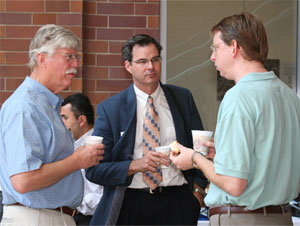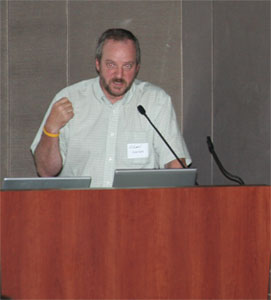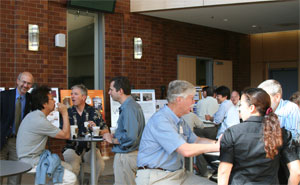Workshop Moves Multidisciplinary Research Forward
By Anna Lynn Spitzer
|
Irvine, Calif., June 3, 2008 -- A workshop held last week at Calit2@UCI reinforced the institute’s multidisciplinary approach to technology. “LifeChips, Stem Cells and Cancer” featured a dozen researchers from three prominent UCI research institutes and an auditorium of academics in a wide range of fields who spent the day delving into each others’ work and looking for ways to jumpstart new interdisciplinary projects.
Sponsored by UC Irvine’s LifeChips program, the Sue and Bill Gross Stem Cell Research Center and the Chao Family Comprehensive Cancer Center, the workshop gave scientists from life sciences, physical sciences, medicine and engineering an opportunity to get acquainted, learn about their peers’ research and discuss potential future collaborations.
Event speakers included Noo-Li Jeon, biomedical engineering; Lisa Flanagan, pathology; Edward Nelson, hematology/oncology; Gregory Weiss, chemistry; Andrej Luptak, chemistry; Felix Grun, developmental and cell biology; Elliot Botvinick, Beckman Laser Institute; GP Li, LifeChips and Calit2; Peter Donovan, biological chemistry; Frank Meyskens, medicine; Stuart Nelson, BLI; and Enrico Gratton, fluorescence dynamics.
|
||||
“This workshop was a great example of Calit2’s goal to advance multidisciplinary research,” said Li, Irvine division director. “The researchers who participated are doing work that spans traditional academic boundaries. This was a great way to initiate discussions about how to pursue future opportunities with each other.”
The event marked the successful conclusion of the second year of UCI’s LifeChips graduate program, which in 2006 was awarded nearly $2.9 million for five years by the National Science Foundation. LifeChips combines the practices of engineering, physical sciences, biological sciences and medicine to produce small-scale technologies that benefit human health.
|
Students in the program study miniaturized technology as it applies to several scientific areas, allowing them to develop a broad base of skills. Biology students learn engineering principles of design and manufacturing, while engineering students study the technology of life that has evolved over 3 billion years.
Graduates of the LifeChips program have the skills necessary to develop technology used to identify new drugs, facilitate stem cell research and improve scientists’ understanding of tissue, organs, genes, proteins, cells, DNA and other basic components of life.





